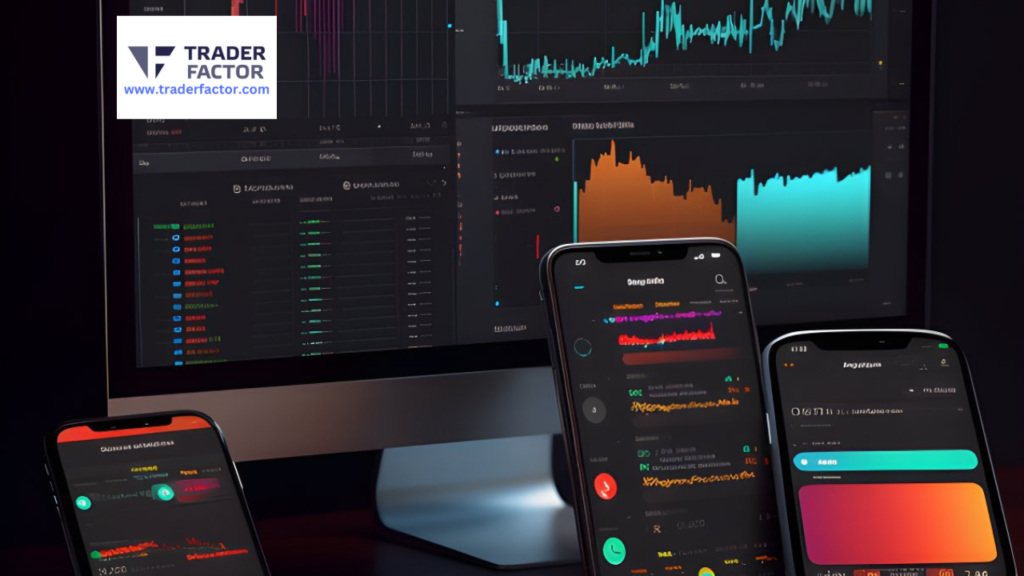Are you a forex trader looking for ways to improve your trading skills? If you are, then you might want to learn about the concept of divergence. It’s a powerful tool that can help you identify potential trend reversals and then trade forex more with more confidence.
Whether you’re a beginner or a seasoned pro, understanding how to use divergence in forex trading can be extremely beneficial.
In this discussion, we’ll explore what divergence is, how it works, and some practical tips on how to use it to your advantage. So, let’s dive in!
Table of Contents
ToggleTypes of Divergence

When it comes to trading divergence in forex, there are several different types of divergence that traders should be aware of. Each type of trade divergence can provide unique trading opportunities and signals. Here are some practical examples and further details on each type:
Regular Divergence
You’ll encounter this diversion when a currency pair price causes extended divergence of a lower to be low, while the indicator used to spot the divergence makes a higher low. This can signal that the current downtrend may soon reverse. Conversely, a bearish scenario is common currency pair price makes a higher high, while the indicator causes a lower to be a lower high. This can signal that the current uptrend may soon reverse.
To identify regular divergence, traders should look for discrepancies between the price chart and the indicator being used. Once divergence occurs identified, traders can use this signal to enter a long or short position, depending on whether the above divergence pattern is bullish or bearish.

Hidden Divergence
This is common when hidden bullish divergence occurs when the price chart makes a higher low, but the oscillator used to spot the divergence causes a lower to be low. This can indicate that the trend is actually stronger than it appears. Traders can use this signal to enter long positions. Hidden bearish divergence, on the other hand, occurs when the price chart causes a lower to be high, but the oscillator makes a higher high. This can signal a potential trend reversal, and traders can use this signal to enter short positions.
To spot hidden divergence, traders must look for discrepancies between the price action and the oscillator being used. This type of hidden divergence patterns can be more difficult to identify than regular divergence, but it can also be more powerful.

MACD Divergence
The Moving Average Convergence Divergence (MACD) is one of the most popular indicators used for trading divergence. It happens when the price chart causes a lower to be low, while the MACD histogram makes a higher low. This can signal a potential upward trend or reversal, and traders can use this signal to enter long positions. On the other hand we say it’s bearish when the price chart makes a higher high, while the MACD histogram causes a lower to be high. This can signal that the current uptrend may soon reverse, and traders can use this signal to enter short positions.
To spot MACD divergence, traders should look for discrepancies between the price chart and the MACD histogram. This type of divergence can be used in conjunction with other technical analysis tools to confirm signals.

RSI Divergence
The Relative Strength Index (RSI) is another widely used indicator for trading divergence. It occurs when the price chart causes a lower to be low, while the RSI indicator makes a higher low. This can indicate that the current downtrend may soon reverse, and traders can use this signal to enter long positions.
A bearish scenario is when the price chart makes a lower lows and a higher high, while the RSI indicator causes a lower to be high. This can signal that the price reversal current uptrend may soon reverse, and traders can use this signal to enter short positions.
To spot RSI divergence, traders should compare the movements of the RSI indicator and the price chart. This type leading indicator of divergence can be more reliable on longer time frames.

Stochastic Divergence
The Stochastic oscillator is yet another popular indicator used for trading divergence. This type entry signal of divergence is inherent when the price chart causes a lower to be low, while the Stochastic oscillator makes a higher low. This can signal that the current downtrend may soon reverse, and traders can use this signal to enter long positions.
On the flipside you’ll encounter a bearish scenario when the price chart makes a higher high, and higher lows, while the Stochastic oscillator causes a lower to be high. This can signal that the current uptrend may soon reverse, and traders can use this signal to enter short positions.
To spot Stochastic divergence, traders should compare the movements of the Stochastic oscillator and the price chart. This type of divergence can be used in conjunction with other technical analysis tools to confirm signals.

CCI Divergence
The Commodity Channel Index (CCI) is another indicator used for trading divergence. This scenario is common when the price chart causes a lower to be low, while the CCI indicator makes a higher low. This can signal that the current downtrend may soon reverse, and traders can use this signal to enter long positions.
On the other hand a bearish event happens when the price chart makes a lower low and a higher high, while the CCI indicator causes a lower to be high. This can signal that the current uptrend may soon reverse, and traders can use this signal to enter short positions.
To spot CCI divergence, traders should compare the movements of the CCI trend indicator and the price chart. This type technical indicator of divergence can be more reliable on longer time frames.
Importance of Divergence in Forex

Divergence is a popular technical analysis tool used by forex traders to identify potential trend reversals and trade opportunities. Here are some reasons why divergence is important in forex trading:
Early Warning Signals
One of the most significant benefits of using divergence in forex trading is that it can provide early warning signals of potential trend reversals. By identifying divergences between the price chart and an oscillator, traders can get a sense of the underlying momentum of the market and whether a trend is likely to continue or reverse.
Confirmation of Trends
In addition to identifying potential reversals, divergence can also confirm trends. If an oscillator is moving in the opposite direction to the price trend or the same direction as the price chart, it can provide additional confirmation that the trend is likely to continue.

Helps to Avoid False Signals
Divergence can also help to avoid false signals. For example, if a trader sees a bearish candlestick pattern, they may be tempted to enter a short position. However, if they also see bullish divergence on an oscillator, they may be more hesitant to take the trade.
Identifies Overbought/Oversold Levels
Divergence can also help traders identify overbought or oversold levels. For example, if a trader sees bearish divergence on an oscillator while the price chart is in overbought territory, they may be more confident in entering a short position.
Provides a Trading Edge
Finally, using divergence in conjunction with other technical analysis tools can give traders a unique edge in the market. By identifying patterns and signals that other traders may not be aware of, traders can make more informed and profitable, trading strategies and decisions.
Steps for Using Divergence

Divergence can be a powerful tool for forex traders, but it is important to use it correctly. Here are the steps you should follow when using divergence in your trading strategy:
Identify the Type of Divergence
The first step in using divergence is to identify the type of divergence you are seeing. As we discussed earlier, there are several different types of divergence, including: regular bullish and bearish divergences divergence and bearish divergence, hidden bullish and bearish divergence, MACD divergence, RSI divergence, Stochastic divergence, and CCI divergence. Understanding the different types of divergence and how to spot them is essential for using this tool effectively.
Confirm the Divergence
Once you have identified a potential divergence signal, the next step is to confirm it. This means using other technical analysis tools to verify that the signal is accurate. For example, if you see bullish divergence on an oscillator, you may also want to look for extended bullish divergence on candlestick patterns or other indicators that suggest the trend is likely to reverse.

Consider the Time Frame
It is also important to consider the time frame when using divergence. Divergence signals can occur on all time frames, from the 1-minute chart to the monthly chart. However, the validity of the signal can vary depending on the time frame. For example, a bullish divergence signal on a 1-minute chart may not be as reliable as a bullish divergence signal on a daily chart.
Develop a Trading Strategy
Once you have confirmed a divergence signal and considered the time frame, the next step is to develop a trading strategy. This means deciding what type of trade to take, where to enter the trade, and where to place your stop loss and take profit orders. It is essential to have a clear plan before entering any trade.
Monitor the Market
Finally, it is important to monitor the market and adjust your strategy as needed. Divergence signals can be powerful, but they are not foolproof. It is essential to stay up-to-date on market news and events that may impact your trades and adjust your strategy accordingly.
Cons of Divergence

While divergence can be a useful tool for forex traders, there are also some drawbacks to using it in your trading strategy. Here are some cons of divergence to consider:
Difficult to Interpret
One of the biggest challenges with divergence is that it can be difficult to interpret. This is especially true for newer traders who may not be as familiar with technical analysis. It can take time and practice to learn how to spot and use divergence signals effectively.
Not Always Accurate
Another potential downside of using divergence is that it is not always accurate. Like any technical analysis tool, divergence can provide false signals or mislead traders. It is important to use divergence in conjunction with other technical analysis tools and to confirm signals before entering trades.

Can Be Overused
Divergence can be a powerful tool, but it is possible to overuse it. Using too many indicators or relying too heavily on divergence can lead to analysis paralysis and hurt your trading performance. It is important to find a balance between using divergence and other technical analysis tools.
May Require Additional Technical Analysis
In addition to potentially overusing divergence, traders may also need to use additional technical analysis tools to confirm signals. For example, if you see bullish divergence on an oscillator, you may also want to look for hidden bullish divergence in candlestick patterns or other indicators that suggest the trend is likely to reverse.
Common Mistakes to Avoid When Trading Divergence in Forex

While divergence can be a powerful tool for forex traders, it is important to avoid common mistakes that can hurt your trading performance.
Ignoring the Trend
One of the most common mistakes traders make when using divergence is ignoring the overall trend. Divergence signals should always be viewed in the context of the broader trend. For example, if there is an uptrend on the daily chart, but a bearish divergence signal appears on a 1-hour chart, it may not be wise to enter a short position.
Using Divergence in Isolation
Another mistake traders make is relying too heavily on divergence and not using other technical indicators and analysis tools to confirm signals. Divergence should be used in conjunction with other indicators and chart patterns to increase the likelihood of accurate signals.

Focusing on a Single Indicator
It is also important to avoid focusing too much on a single indicator when trading divergence. While oscillators like the MACD, RSI, Stochastic, and CCI are commonly used in conjunction with divergence, relying solely on one oscillator can lead to inaccurate signals.
Misinterpreting Divergence Signals
Misinterpreting divergence signals is another common mistake traders make. Just because a divergence signal appears, does not necessarily mean that a trend reversal is imminent. It is essential to confirm divergence signals with other indicators and to consider the broader market conditions before entering any trade.
Overtrading
Overtrading is a common mistake that can hurt your trading performance, regardless of the strategy you use. When using divergence, it is important to be patient and wait for high-probability signals to appear. Jumping into trades too quickly or based on weak signals can lead to losses.

Failing to Use Stop Losses
Finally, failing to use stop losses is a critical mistake to avoid when trading divergence. While divergence can be a powerful tool, it is not foolproof. It is essential to have risk management measures in place to limit potential losses.
How to Use Divergence in Forex Trading: FAQs

1. What is divergence in forex trading?
Divergence refers to a discrepancy between an oscillator and the price chart in the forex market. It is a technical analysis tool that can be used to identify potential trend reversals and trade opportunities.
2. What are the different types of divergence?
There are several different types of divergence, including: regular bullish divergence occurs, and regular bearish divergence, hidden bullish and bearish divergence, MACD divergence, RSI divergence, Stochastic divergence, and CCI divergence. Each type of divergence provides unique information about market trends and momentum.

3. How do I spot divergence signals?
To spot extended bearish divergence signals, you should look for discrepancies between an oscillator and the price chart. For example, if the price chart is making higher highs but the oscillator is making lower highs, it could signal a potential bearish divergence.
4. How do I confirm divergence signals?
To confirm divergence signals, it is important to use other technical analysis tools like candlestick patterns and trend lines. Confirming signals can increase the accuracy of your trades and reduce the risk of losses.
5. How do I use divergence in my trading strategy?
To use divergence in your trading strategy, you should consider the trend, time frame, and other technical analysis tools. It is important to have a clear plan before entering any trade and to use risk management measures like stop losses to limit potential losses.

Conclusion
Using divergence in forex trading can be a powerful tool for identifying potential trend reversals and trade opportunities. However, it is important to use divergence correctly and avoid common mistakes like ignoring the trend, using divergence in isolation, focusing on a single indicator, misinterpreting signals, overtrading, and failing to use stop losses. By following best practices when using divergence, traders can increase their chances of success and make more informed trading decisions. Additionally, by understanding the different types of divergence, how to spot and confirm signals, and how to incorporate divergence trading into a broader trading strategy, traders can improve their overall performance and achieve their financial goals in the forex market.
Disclaimer:
All information has been prepared by TraderFactor or partners. The information does not contain a record of TraderFactor or partner’s prices or an offer of or solicitation for a transaction in any financial instrument. No representation or warranty is given as to the accuracy or completeness of this information. Any material provided does not have regard to the specific investment objective and financial situation of any person who may read it. Past performance is not a reliable indicator of future performance.
Author

Zahari Rangelov is an experienced professional Forex trader and trading mentor with knowledge in technical and fundamental analysis, medium-term trading strategies, risk management and diversification. He has been involved in the foreign exchange markets since 2005, when he opened his first live account in 2007. Currently, Zahari is the Head of Sales & Business Development at TraderFactor's London branch. He provides lectures during webinars and seminars for traders on topics such as;Psychology of market participants’ moods, Investments & speculation with different financial instruments and Automated Expert Advisors & signal providers.Zahari’s success lies in his application of research-backed techniques and practices that have helped him become a successful forex trader, a mentor to many traders, and a respected authority figure within the trading community.
View all posts
















